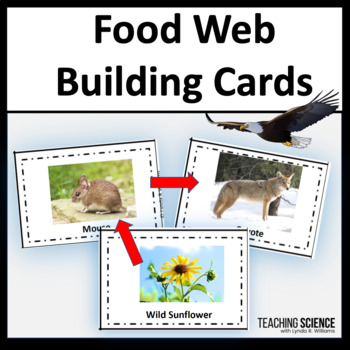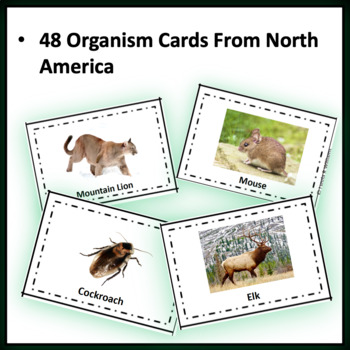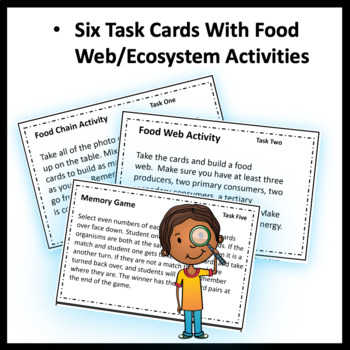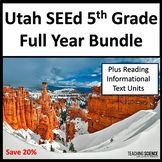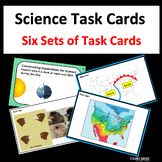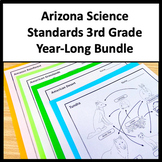Food Chains and Food Webs Task Cards and Ecosystem Activities & Flow of Energy
- PDF
What educators are saying
Also included in
- Do you teach 5th grade in Indiana? You need this bundle of 5th-grade science Indiana resources. This Indiana fifth-grade bundle covers all the science standards for Indiana 5th grade. It is a full-year bundle, and you save 20% on these resources by purchasing in the bundle! This is aligned with thePrice $87.36Original Price $109.20Save $21.84
- 5th Grade Utah SEEd Bundle: This is a year's worth of lessons and units that address all of the Utah SEEd standards for 5th grade. These units use phenomena, science and engineering practices, and crosscutting concepts to help students think critically and deepen their understanding. Save 20% by purPrice $113.23Original Price $141.54Save $28.31
- This is a set of science task cards for grades 5-8. Each set of task cards comes with answer sheets and answer keys. These task cards are self-checking with the answer keys. Save 20% by purchasing this bundle. No-prep! Great for Emergency Sub Plans.Topics and Task Cards Included:•Weather Map Task CaPrice $22.80Original Price $28.50Save $5.70
- This is a science bundle for the Arizona Science Standards for 3rd Grade. This resource covers the standards for Arizona Science 3rd Grade. Arizona has specificstandards that align with the resources I have included. Each standard is addressed by one or more resources. Based on the Arizona Science SPrice $53.76Original Price $67.20Save $13.44
Description
Are you looking for an engaging way to learn about food webs? This resource includes 48 Food Web sorting cards with producers, primary consumers, secondary consumers, and decomposers. Animal and plant species are native to North America. Students will sort cards in 6 different Food Web and Food Chain tasks. Students will identify trophic levels, energy flow, producers and consumers, and more. This resource addresses the Disciplinary Core Ideas for NGSS Ecosystem: Interactions, Energy, and dynamics.
This resource includes
•48 organism cards
•6 task cards
•Answer sheets
Tasks Include:
•Building a Food Web
•Building a food Chain
•Identifying trophic levels
•Memory Game
•Food Chain Challenge
•What do they eat?
Science Concepts include:
- food chains
- food webs
- producers, consumers, decomposers
- herbivore, carnivore, omnivore
- trophic levels
- ecosystem
- autotrophs and heterotrophs
Teachers Love This Resource!
Kristen ⭐️ ⭐️ ⭐️ ⭐️ ⭐️ Extremely Satisfied
"This was great for my science rotations. Students created a variety of food webs and chains, and the task cards were easy to follow. Great information".
Peggy ⭐️ ⭐️ ⭐️ ⭐️ ⭐️ Extremely Satisfied
"These were great for my 7th-grade life science class. Students enjoyed sorting and making food webs and the task cards had great questions".
Save 20% by purchasing in Utah SEEd 5th Grade PLUS Reading Units Bundle
Great for small groups, partner work, centers, and fast finishers.
Standards This Resource Addresses:
NGSS 5-PS3-1. Use models to describe that energy in animals’ food (used for body repair, growth, motion, and to maintain body
warmth) was once energy from the sun.
and
NGSS 5-LS2-1. Develop a model to describe the movement of matter among plants, animals, decomposers, and the environment.
Utah SEEd 5.3.2 Obtain, evaluate, and communicate information that animals obtain energy and matter from the food they eat for body repair, growth, and motion and to maintain body warmth. Emphasize that the energy used by animals was once energy from the Sun. Cellular respiration will be taught in Grades 6 through
Utah SEEd 5.3.3 Develop and use a model to describe the movement of matter among plants, animals, decomposers, and the environment. Emphasize that matter cycles between the air and soil and among plants, animals, and microbes as these organisms live and die. Examples could include simple food chains from ecosystems such as deserts or oceans or diagrams of decomposers returning matter to the environment.
Utah SEEd 6.4.3 Develop a model to describe the cycling of matter and flow of energy among living and nonliving parts of an ecosystem.
NGSS MS LS2-3 Develop a model to describe the cycling of matter and flow of energy among living and nonliving parts of an ecosystem.
See the preview for more details!
Please look at some of my other science resources:

